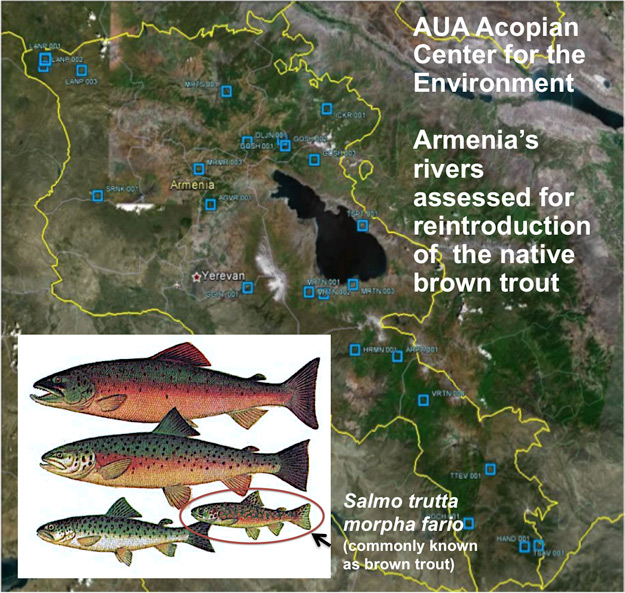
AUA Acopian Center for the Environment Studies Native Fish Repopulation in Armenia
2 min readYEREVAN – The American University of Armenia (AUA)’s Acopian Center for the Environment (AUA ACE), with support from the German Organization for International Cooperation (GIZ), has conducted an extensive survey of the physical and chemical properties of 22 rivers and streams in seven provinces of Armenia. The aim of the survey was to determine the suitability of the rivers for the reintroduction of the brown trout population.
Overfishing in the 1990s led to a collapse of brown trout (Salmo trutta morpha fario) stocks throughout Armenia. This species, once available abundantly in all of Armenia’s provinces, is currently found in fewer than 20% of surveyed rivers.
“The results of the survey are promising,” says Dr. Karen Aghababyan, chief scientist of the AUA Acopian Center for the Environment and the study’s principal investigator. “Most rivers studied are suitable for the reintroduction of the species. Their oxygen and pH levels were within the range preferred by the brown trout, and most sites had appropriate levels of ammonia and carbon dioxide, as well as enough benthic invertebrates to serve as food for the reintroduced fish.”
In addition to scouting river sites, AUA ACE researchers found an appropriate brood stock with which to populate the rivers in question. To this end, AUA ACE has collaborated with a fish farm that had captured wild brown trout from the Arpa River in 2009. This trout, which has not interbred with other fish species and has not gone through artificial selection, carries all the genes of the wild population and is suitable for introduction into the native stocks.
For decades, the brown trout has been a staple fish in diets worldwide. In most parts of the world, brown trout is interbred with local populations, resulting in fish that are genetically different from their ancestors. Very few places on Earth are home to genetically pure brown trout. Armenia is one of these places, with its mountainous rivers providing protection from interbreeding with non-indigenous species.
A successful reintroduction of a fish species needs more than adequate water conditions and pure breed. “We also need to ensure that the site is protected from poachers. Communities close to these fish populations have to have an economic incentive to protect them. Local stewardship of the fish stock has to be worked into the reintroduction,” says Dr. Aghababyan.

River sites surveyed by AUA ACE from 2010 to 2012 as part of the GIZ funded project. Four varieties from the genus salmo with the circled one, the brown trout (salmo trutta morpha fario) indigenous to Armenia’s rivers, considered for reintroduction. (Fish images courtesy of Определитель составлен по материалам книги Е. А. Веселова “Определитель пресноводных рыб фауны СССР”; Москва, “Просвещение”, 1977 г)
The AUA Acopian Center for the Environment (AUA ACE) is a research center of the American University of Armenia. AUA ACE promotes the protection and restoration of the natural environment through research, education, and community outreach. AUA ACE’s focus areas include sustainable natural resource management, biodiversity and conservation, greening the built environment, clean energy and energy efficiency, as well as information technology and the environment.

Comments are closed, but trackbacks and pingbacks are open.